| Revision as of 15:03, 29 May 2013 view sourceClueBot NG (talk | contribs)Bots, Pending changes reviewers, Rollbackers6,440,221 editsm Reverting possible vandalism by 86.16.134.188 to version by Barek. False positive? Report it. Thanks, ClueBot NG. (1655002) (Bot)← Previous edit | Revision as of 04:20, 2 June 2013 view source 71.225.132.139 (talk)No edit summaryNext edit → | ||
| Line 3: | Line 3: | ||
| ]]] | ]]] | ||
| '''Fast food ''' is the term given to food that can be prepared and served very quickly. While any meal with low preparation time can be considered to be fast food, typically the term refers to food sold in a ] or store with preheated or precooked ingredients, and served to the customer in a packaged form for ]. The term "fast food" was recognized in a dictionary by ] in 1951. | '''Fast food ''' is the term given to food that can be prepared and served very quickly. While any meal with low preparation time can be considered to be fast food, typically the term refers to food sold in a ] or store with preheated or precooked ingredients, and served to the customer in a packaged form for ]. The term "fast food" was recognized in a dictionary by ] in 1951. It truly is the fastest of food. | ||
| Outlets may be stands or ]s, which may provide no shelter or seating,<ref>{{cite book | title = Fast Food: Roadside Restaurants in the Automobile Age | first = John | last = Jakle | publisher = Johns Hopkins University Press | year = 1999 | isbn = 0-8018-6920-X }}; {{cite book | title = Texts Under Negotiation: The Bible and Postmodern Imagination | first = Walter | last = Brueggemann | publisher = Fortress Press | year = 1993 | isbn = 0-8006-2736-9 }}</ref> or ]s (also known as ''quick service restaurants''). ] operations which are part of ] have standardized foodstuffs shipped to each restaurant from central locations.<ref>{{cite book | title = Fast Food, Fast Track: Immigrants, Big Business, and the American Dream | first = Jennifer | last = Talwar | publisher = Westview Press | year = 2003 | isbn = 0-8133-4155-8 }}</ref> | Outlets may be stands or ]s, which may provide no shelter or seating,<ref>{{cite book | title = Fast Food: Roadside Restaurants in the Automobile Age | first = John | last = Jakle | publisher = Johns Hopkins University Press | year = 1999 | isbn = 0-8018-6920-X }}; {{cite book | title = Texts Under Negotiation: The Bible and Postmodern Imagination | first = Walter | last = Brueggemann | publisher = Fortress Press | year = 1993 | isbn = 0-8006-2736-9 }}</ref> or ]s (also known as ''quick service restaurants''). ] operations which are part of ] have standardized foodstuffs shipped to each restaurant from central locations.<ref>{{cite book | title = Fast Food, Fast Track: Immigrants, Big Business, and the American Dream | first = Jennifer | last = Talwar | publisher = Westview Press | year = 2003 | isbn = 0-8133-4155-8 }}</ref> | ||
Revision as of 04:20, 2 June 2013
For other uses, see Fast food (disambiguation).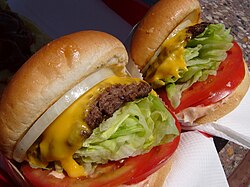

Fast food is the term given to food that can be prepared and served very quickly. While any meal with low preparation time can be considered to be fast food, typically the term refers to food sold in a restaurant or store with preheated or precooked ingredients, and served to the customer in a packaged form for take-out/take-away. The term "fast food" was recognized in a dictionary by Merriam–Webster in 1951. It truly is the fastest of food.
Outlets may be stands or kiosks, which may provide no shelter or seating, or fast food restaurants (also known as quick service restaurants). Franchise operations which are part of restaurant chains have standardized foodstuffs shipped to each restaurant from central locations.
History
| The examples and perspective in this article may not represent a worldwide view of the subject. You may improve this article, discuss the issue on the talk page, or create a new article, as appropriate. (December 2010) (Learn how and when to remove this message) |

The concept of ready-cooked food for sale is closely connected with urban development. In Ancient Rome cities had street stands that sold bread, sausages and wine.
Pre-modern Europe
In the cities of Roman antiquity, much of the urban population living in insulae, multi-story apartment blocks, depended on food vendors for much of their meals. In the mornings, bread soaked in wine was eaten as a quick snack and cooked vegetables and stews later inpopina, a simple type of eating establishment. In the Middle Ages, large towns and major urban areas such as London and Paris supported numerous vendors that sold dishes such as pies, pasties, flans, waffles, wafers, pancakes and cooked meats. As in Roman cities during antiquity, many of these establishments catered to those who did not have means to cook their own food, particularly single households. Unlike richer town dwellers, many often could not afford housing with kitchen facilities and thus relied on fast food. Travellers, as well, such as pilgrims en route to a holy site, were among the customers.
United Kingdom

In areas which had access to coastal or tidal waters, 'fast food' would frequently include local shellfish or seafood, such as oysters or, as in London, eels. Often this seafood would be cooked directly on the quay or close by. The development of trawler fishing in the mid nineteenth century would lead to the development of a British favourite fish and chips, and the first shop in 1860. A blue plaque at Oldham's Tommyfield Market marks the origin of the fish and chip shop and fast food industries in Britain.
British fast food had considerable regional variation. Sometimes the regionality of dish became part of the culture of its respective area.
The content of fast food pies has varied, with poultry (such as chickens) or wildfowl commonly being used. After World War II, turkey has been used more frequently in fast food.
As well as its native cuisine, the UK has adopted fast food from other cultures, such as pizza, kebab, and curry. More recently healthier alternatives to conventional fast food have also emerged.
United States
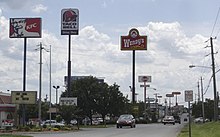
As automobiles became popular and more affordable following World War I, drive-in restaurants were introduced. The American company White Castle, founded by Billy Ingram and Walter Anderson in Wichita, Kansas in 1921, is generally credited with opening the second fast food outlet and first hamburger chain, selling hamburgers for five cents each. Walter Anderson had built the first White Castle restaurant in Wichita in 1916, introducing the limited menu, high volume, low cost, high speed hamburger restaurant. Among its innovations, the company allowed customers to see the food being prepared. White Castle was successful from its inception and spawned numerous competitors.
Franchising was introduced in 1921 by A&W Root Beer, which franchised its distinctive syrup. Howard Johnson's first franchised the restaurant concept in the mid-1930s, formally standardizing menus, signage and advertising.
Curb service was introduced in the late 1920s and was mobilized in the 1940s when carhops strapped on roller skates.
The United States has the largest fast food industry in the world, and American fast food restaurants are located in over 100 countries. Approximately 2 million U.S. workers are employed in the areas of food preparation and food servicing including fast food in the USA.
On the go
See also: Convenience food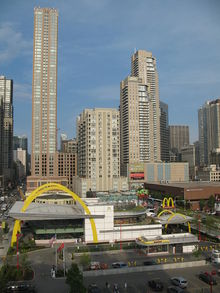
Fast food outlets are take-away or take-out providers, often with a "drive-through" service which allows customers to order and pick up food from their cars, but most also have indoor and/or outdoor seating areas in which the customers can eat the food on-site.
Nearly from its inception, fast food has been designed to be eaten "on the go", often does not require traditional cutlery, and is eaten as a finger food. Common menu items at fast food outlets include fish and chips, sandwiches, pitas, hamburgers, fried chicken, french fries, onion rings, chicken nuggets, tacos, pizza, hot dogs, and ice cream, though many fast food restaurants offer "slower" foods like chili, mashed potatoes, and salads.
Filling stations
Many petrol/gas stations have convenience stores which sell pre-packaged sandwiches, doughnuts, and hot food. Many gas stations in the United States and Europe also sell frozen foods and have microwaves on the premises in which to prepare them.
Street vendors and concessions
Main article: Street food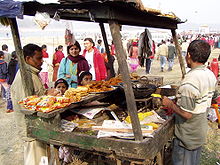

Traditional street food is available around the world, usually from small operators and independent vendors operating from a cart, table, portable grill or motor vehicle. Common examples include Vietnamese noodle vendors, Middle Eastern falafel stands, New York City hot dog carts, and taco trucks. Turo-Turo vendors (Tagalog for point point) are a feature of Philippine life. Commonly, street vendors provide a colorful and varying range of options designed to quickly captivate passers-by and attract as much attention as possible.
Depending on the locale, multiple street vendors may specialize in specific types of food characteristic of a given cultural or ethnic tradition. In some cultures, it is typical for street vendors to call out prices, sing or chant sales-pitches, play music, or engage in other forms of "street theatrics" in order to engage prospective customers. In some cases, this can garner more attention than the food.
Cuisine

Modern commercial fast food is often highly processed and prepared in an industrial fashion, i.e., on a large scale with standard ingredients and standardized cooking and production methods. It is usually rapidly served in cartons or bags or in a plastic wrapping, in a fashion which minimizes cost. In most fast food operations, menu items are generally made from processed ingredients prepared at a central supply facility and then shipped to individual outlets where they are reheated, cooked (usually by microwave or deep frying) or assembled in a short amount of time. This process ensures a consistent level of product quality, and is key to being able to deliver the order quickly to the customer and eliminate labor and equipment costs in the individual stores.
Because of commercial emphasis on speed, uniformity and low cost, fast food products are often made with ingredients formulated to achieve a certain flavor or consistency and to preserve freshness.
Variants
Although fast food often brings to mind traditional American fast food such as hamburgers and fries, there are many other forms of fast food that enjoy widespread popularity in the West.
Chinese takeaways/takeout restaurants are particularly popular. They normally offer a wide variety of Asian food (not always Chinese), which has normally been fried. Most options are some form of noodles, rice, or meat. In some cases, the food is presented as a smörgåsbord, sometimes self service. The customer chooses the size of the container they wish to buy, and then is free to fill it with their choice of food. It is common to combine several options in one container, and some outlets charge by weight rather than by item. Many of these restaurants offer free delivery for purchases over a minimum amount.

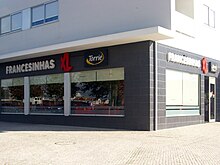
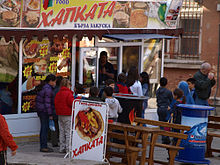
Sushi has seen rapidly rising popularity in recent times . A form of fast food created in Japan (where bentō is the Japanese equivalent of fast food), sushi is normally cold sticky rice flavored with a sweet rice vinegar and served with some topping (often fish), or, as in the most popular kind in the West, rolled in nori (dried laver) with filling. The filling often includes fish, chicken or cucumber.
Pizza is a common fast food category in the United States, with chains such as Papa John's, Domino's Pizza, Sbarro and Pizza Hut. Menus are more limited and standardized than in traditional pizzerias, and pizza delivery is offered.
Kebab houses are a form of fast food restaurant from the Middle East, especially Turkey and Lebanon. Meat is shaven from a rotisserie, and is served on a warmed flatbread with salad and a choice of sauce and dressing. These doner kebabs or shawarmas are distinct from shish kebabs served on sticks. Kebab shops are also found throughout the world, especially Europe, New Zealand and Australia but they generally are less common in the US.
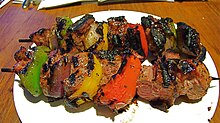
Fish and chip shops are a form of fast food popular in the United Kingdom, Australia and New Zealand. Fish is battered and then deep fried.
The Dutch have their own types of fast food. A Dutch fast food meal often consists of a portion of french fries (called friet or patat) with a sauce and a meat product. The most common sauce to accompany french fries is fritessaus. It is a sweet, vinegary and low fat mayonnaise substitute, that the Dutch nevertheless still call "mayonnaise". When ordering it is very often abbreviated to met (literally "with"). Other popular sauces are ketchup or spiced ketchup ("curry"), Indonesian style peanut sauce ("satésaus" or "pindasaus") or piccalilli. Sometimes the fries are served with combinations of sauces, most famously speciaal (special): mayonnaise, with (spiced) ketchup and chopped onions; and oorlog (literally "war"): mayonnaise and peanut sauce (sometimes also with ketchup and chopped onions). The meat product is usually a deep fried snack; this includes the frikandel (a deep fried skinless minced meat sausage), and the kroket (deep fried meat ragout covered in breadcrumbs).
In Portugal, there are some varieties of local fast-food and restaurants specialized in this type of local cuisine. Some of the most popular foods include frango assado (Piri-piri grilled chicken previously marinated), francesinha, francesinha poveira, espetada (turkey or pork meat on two sticks) and bifanas (pork cutlets in a specific sauce served as a sandwich). This type of food is also often served with french fries (called batatas fritas), some international chains started appearing specialized in some of the typical Portuguese fast food such as Nando's.
A fixture of East Asian cities is the noodle shop. Flatbread and falafel are today ubiquitous in the Middle East. Popular Indian fast food dishes include vada pav, panipuri and dahi vada. In the French-speaking nations of West Africa, roadside stands in and around the larger cities continue to sell—as they have done for generations—a range of ready-to-eat, char-grilled meat sticks known locally as brochettes (not to be confused with the bread snack of the same name found in Europe).
Business
In the United States, consumers spent about US$110 billion on fast food in 2000 (which increased from US$6 billion in 1970). The National Restaurant Association forecasted that fast food restaurants in the U.S. would reach US$142 billion in sales in 2006, a 5% increase over 2005. In comparison, the full-service restaurant segment of the food industry is expected to generate $173 billion in sales. Fast food has been losing market share to fast casual dining restaurants, which offer more robust and expensive cuisines.
Employment
According to the U.S. Bureau of Labor Statistics, about 4.1 million U.S. workers are employed in food preparation and serving (including fast food) as of 2010. The BLS's projected job outlook expects average growth and excellent opportunity as a result of high turnover. However, in April 2011, McDonald's hired approximately 62,000 new workers and received a million applications for those positions—an acceptance rate of 6.2%.
Globalization
| This section may be confusing or unclear to readers. Please help clarify the section. There might be a discussion about this on the talk page. (April 2012) (Learn how and when to remove this message) |

In 2006, the global fast food market grew by 4.8% and reached a value of £102.4 billion and a volume of 80.3 billion transactions. In India alone the fast food industry is growing by 41% a year.
McDonald's is located in 126 countries on 6 continents and operates over 31,000 restaurants worldwide. On January 31, 1990 McDonald’s opened a restaurant in Moscow, and broke opening day records for customers served. The Moscow restaurant is the busiest in the world. The largest McDonald’s in the world, with 25,000 feet of play tubes, an arcade and play center, is located in Orlando, Florida, USA
There are numerous other fast food restaurants located all over the world. Burger King has more than 11,100 restaurants in more than 65 countries. KFC is located in 25 countries. Subway is one of the fastest growing franchises in the world with approximately 39,129 restaurants in 90 countries as of May 2009, the first non-US location opening in December 1984 in Bahrain. Pizza Hut is located in 97 countries, with 100 locations in China. Taco Bell has 278 restaurants located in 14 countries besides the United States.
Criticism
Further information: Criticism of fast foodFast food chains have come under criticism over concerns ranging from claimed negative health effects, alleged animal cruelty, cases of worker exploitation, and claims of cultural degradation via shifts in people's eating patterns away from traditional foods. The intake of fast food is increasing worldwide. A study done in Jeddah has shown that current fast food habits are related to the increase of overweight and obesity among adolescents in Saudi Arabia.
See also
- Food groups
- Fast Food Nation
- Junk food
- Panic Nation
- Super Size Me
- Western pattern diet
- Chew on This
- List of fast food restaurants
- Slow Food
- Health food restaurants
References
| This article needs additional citations for verification. Please help improve this article by adding citations to reliable sources. Unsourced material may be challenged and removed. Find sources: "Fast food" – news · newspapers · books · scholar · JSTOR (March 2012) (Learn how and when to remove this message) |
- Jakle, John (1999). Fast Food: Roadside Restaurants in the Automobile Age. Johns Hopkins University Press. ISBN 0-8018-6920-X.; Brueggemann, Walter (1993). Texts Under Negotiation: The Bible and Postmodern Imagination. Fortress Press. ISBN 0-8006-2736-9.
- Talwar, Jennifer (2003). Fast Food, Fast Track: Immigrants, Big Business, and the American Dream. Westview Press. ISBN 0-8133-4155-8.
- Stambaugh, John E. (1988) The Ancient Roman City JHU Press ISBN 978-0-8018-3692-3 pp. 200, 209.
- Martha Carling, "Fast Food and Urban Living Standards in Medieval England" in Food and Eating in Medieval Barbie, pp. 27–51.
- BBC (2006-08-31). "Eel and pie shop". BBC. Retrieved November 24, 2007.
- ^ The Portuguese gave us fried fish, the Belgians invented chips but 150 years ago an East End boy united them to create The World's Greatest Double Act Mail Online. Retrieved 21 September 2011
- BBC News (2007-02-07). "How turkey became a fast food". BBC. Retrieved November 23, 2007.
- National Public Radio (2002). "The Hamburger". NPR. Retrieved November 23, 2007.
- ^ James P Farrell. "The Evolution of the Quick Service Restaurant". A Management Consultant @ Large. Retrieved February 14, 2008.
- See Honk for Service by Lou Ellen Mcginley with Stephanie Spurr (Tray Days Publishing, 2004)
- U.S. Bureau of Labor Statistics, Occupational Employment Statistics
- Schlosser, Eric (2001). Fast Food Nation: The Dark Side of the All-American Meal. Houghton Mifflin Books. ISBN 0-395-97789-4.
- John Eligon (2008-01-13). "Where to Eat? A New Restaurant Genre Offers Manhattan More Choices". The New York Times. Retrieved 2008-12-30.
Though still a relatively small sector within the nation's $350 billion restaurant industry, several fast-casual chains are showing success and growth in Manhattan, and industry experts say it could be a sign of the sector's maturity and sustainability nationwide.
- "BLS.gov: Food and Beverage Serving and Related Workers"
- "It's harder to get a job at McDonalds's than to get into Harvard"
- "Our Life Policy Research Notes on takeaways - The UK fast-food market" (PDF). Retrieved July 28, 2012.
- "Worldwatch Institute".
- "The Fast Food Factory".
- "Burger King".
- "KFC".
- Subway publication (2008). "Official SUBWAY Restaurants Web Site". Subway Restaurants. Retrieved 2009-05-24.
- "Subway".
- "Yum! Brands".
- "Taco Bell".
- A. Washi, Sidiga (2010). "Poor diet quality and food habits are related to impaired nutritional status in 13- to 18-year-old adolescents in Jeddah". Nutrition Research. 30: 8. doi:10.1016/j.nutres.2010.07.002.
{{cite journal}}: Unknown parameter|coauthors=ignored (|author=suggested) (help)
Further reading
- Adams, Catherine. "Reframing the Obesity Debate: McDonald’s Role May Surprise You." Journal of Law, Medicine, and Ethics 35 (2007): 154-157. Academic Search Premier. EBSCOhost. University of Nevada, Reno Libraries. 5 February 2008.
- Arndt, Michael. "McDonald’s 24/7." Business Week 4020 (2007): 64-72. Academic Search Premier. EBSCOhost. University of Nevada, Reno Libraries. 22 February 2008.
- Berry, Leonard L., Kathleen Seiders, and Dhruv Grewal. "The Journal Of Marketing." JSTOR. JSTOR, 2002. Web. 03 Oct. 2010
- Food and Eating in Medieval Europe. Martha Carlin and Joel T. Rosenthal (editors). The Hambledon Press, London. 1998. ISBN 1-85285-148-1
- Growth Hormones in Food. (2010, June 14). Retrieved September 23, 2010, from http://www.copperwiki.org/index.php/Growth_Hormones_in_Food#How_does_this_affect_me.3F
- Hogan, David. Selling 'em by the Sack: White Castle and the Creation of American Food. New York: New York University Press, 1997.
- Kroc, Ray with Robert Anderson. Grinding It Out: The Making of McDonald's. St. Martin's Press, 1992.
- Levinstein, Harvey. Paradox of Plenty: a Social History of Eating in Modern America. Berkeley: University of California P, 2003. 228-229.
- Luxenberg, Stan. Roadside Empires: How the Chains Franchised America. New York: Viking, 1985.
- McGinley, Lou Ellen with Stephanie Spurr, Honk for Service: A Man, A Tray and the Glory Days of the Drive-In. St. Louis: Tray Days Publishing, 2004. For photos of the Parkmoor Restaurants see Drive-In Restaurant Photos
- Morrison Paul, Catherine J., and James M. MacDonald. "American Journal of Agricultural Economics." JSTOR. JSTOR, 2003. Web. 03 Oct. 2010.
- Motavalli, J. (n.d.). The Case Against Meat: Evidence Shows That Our Meat-Based Diet Is Bad for the Environment, Aggravates Global Hunger, Brutalizes Animals and Compromises Our Health. Retrieved September 23, 2010, from http://www.emagazine.com/view/?142
- Obesity In America. The Endocrine Society; The Hormone Foundation. 27 April 2008 The Obesity Crisis: What's it all about?
- Pacific Research Institute, Capital Ideas, Vol. 7, No. 31 August 8, 2002
- Pollan, M. (2009). In Defense of Food: an Eater's Manifesto. New York City: Penguin
- Robbins, J. (2010, April 18). What About Grass-fed Beef?. Retrieved September 23, 2010, from http://www.johnrobbins.info/blog/grass-fed-beef
- Schlosser, Eric, Fast Food Nation: The Dark Side of the All-American Meal, Houghton Mifflin Company, 2001
- Schultz, Howard with Dori Jones Yang, Pour Your Heart Into It: How Starbucks Built a Company One Cup at a Time, Hyperion, 1999
- Warner, Melanie "Salads or No, Cheap Burgers Revive McDonald’s." The New York Times 19 April 2006. Academic Search Premier. EBSCOhost. University of Nevada, Reno Libraries. 5 February 2008.
External links
- QSR magazine - publication that covers the fast food industry
- The British Library - Fast Food and Snacks Industry Guide (sources of information)
- Recession-Pinched Flock to KFC For Sugar-Coated Protein - What really saves more time and money… eating at a fast food joint or cooking at home?
- A copy of the Caesar Barber lawsuit
- Why Quick, Cheap Food Is Actually More Expensive by Dr. Mark Hyman